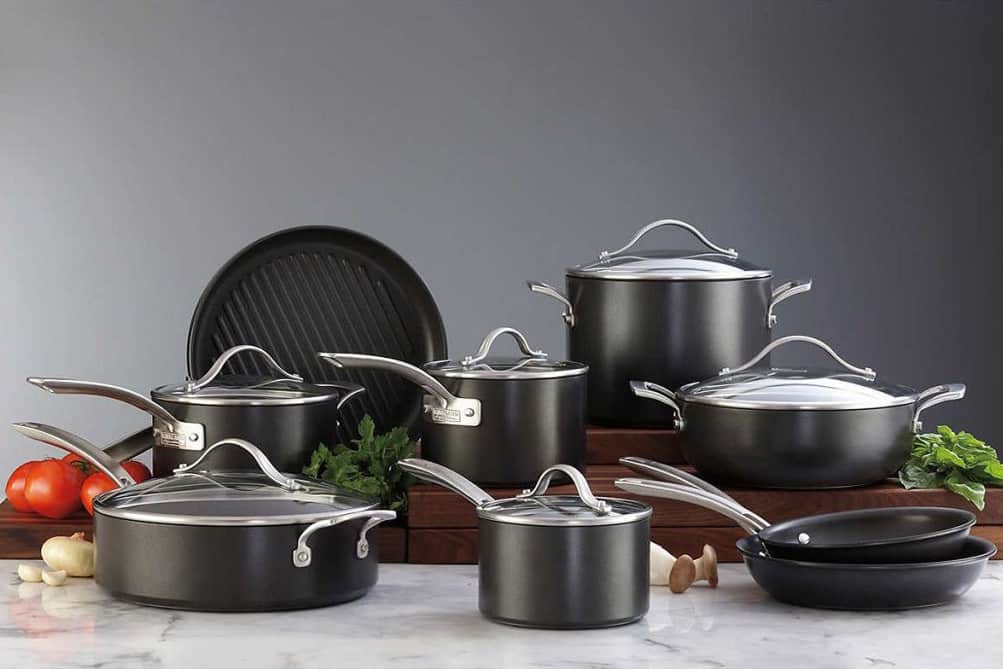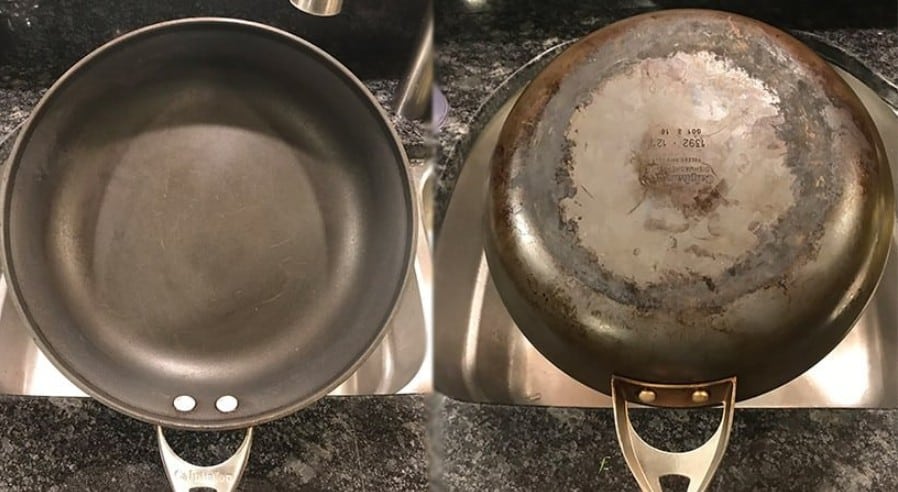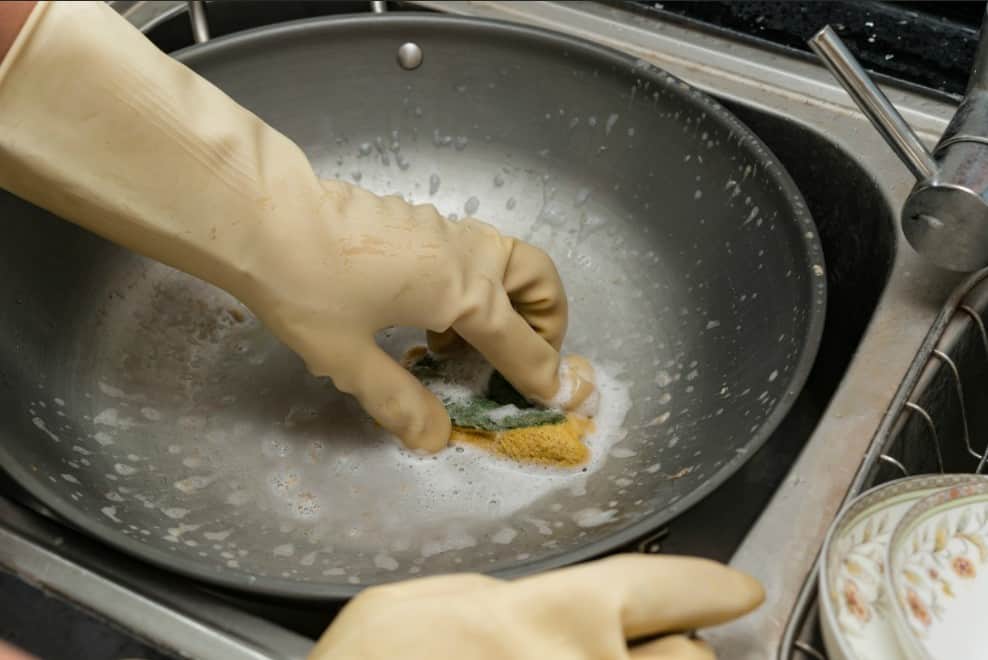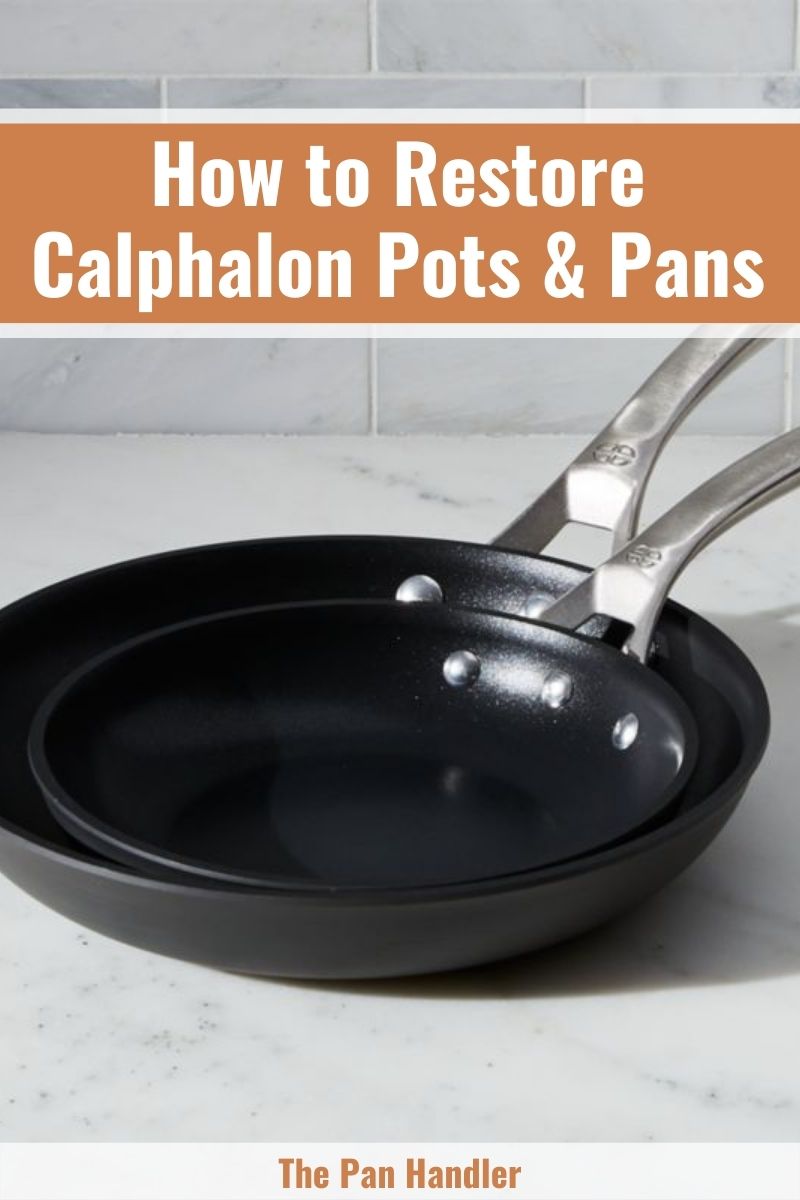Calphalon bakeware and cookware items range from nonstick and stainless steel to hard-anodized aluminum, making them a popular choice among consumers. Calphalon pots and pans should be cared for in specific ways to ensure they function for years. This article will give you step by step guide and ideas for restoring your Calphalon pans or pots.
What is a Calphalon pan?

Calphalon pans are a brand of cookware named after a larger company called “Newell Rubbermaid.” They are well-known for their nonstick coatings, notable for being made of anodized aluminum rather than Teflon, a considerably more prevalent nonstick coating ingredient.
Calphalon cookware has grown in popularity with its nonstick frying pan attracting those who enjoy frying. This kind of cookware is referred to as “hard-anodized” cookware. This company uses an electrochemical process known as hard-anodization to harden the aluminum used for the nonstick surface.
Calphalon pans and pots have aluminum materials, chemicals, and electric pulses must be used, making the material far more durable than standard aluminum. As a result, the cookware’s surface is more resistant to abrasion and corrosion. A hard-anodized piece of this cookware may be one of the most durable pans available.
Restoring Calphalon pans or pots
Because Calphalon cookware lasts for years, frequent use may lead it to malfunction or deteriorate. Don’t worry. There are methods for restoring these pots if the proper procedures are followed. You can revive them with household items such as vinegar, dishwashing liquid, or baking soda.
Using white vinegar to restore burned Calphalon pots and pans
For the best results in restoring your burned or stained Calphalon, use distilled white vinegar. The acidity of vinegar reacts with the burnt layer on your cookware, causing it to lose its grip on the cooking surface and slip off. All you have to do to restore the shine is rinse it off. If white vinegar is not available, you can substitute apple cider vinegar or lemon juice.
- Step 1 – Wipe your soiled pans using a solution of distilled white vinegar and water. Soak the pots and pans first then leave them to rest for 10 to 15 minutes before proceeding. After a short while, the residue will begin to peel away from the surface.
- Step 2 – After the needed time has elapsed, dispose of the vinegar water. Then, using a non-abrasive sponge and a dishwashing liquid, remove any remaining food residue. Make sure nothing sticks to the surface by thoroughly scrubbing it.
- Step 3 – Gently rinse and dry the cooking surface. Make sure your cookware has been thoroughly cleaned and dried before storing it.
Alternatively, you can use 1/2 cup white vinegar and 1/2 cup water. Simmer the mixture in the Calphalon for about 15 minutes over medium-high heat, stirring occasionally. If the burned residue is subjected to heat, it will be easier to remove from the surface.
Restoring slightly- burnt Calphalon pans and pots using dishwashing liquid
The first item you should use to clean burned Calphalon pots and pans is dishwashing liquid. It’s helpful in this case because the pan hasn’t been entirely destroyed by the unintentional burning mishap. Aside from that, the restoration process differs from a conventional wash. Before you can clean the burnt cookware, it must be soaked in a liquid soap mixed with water.
- Step 1 – Use any mild dishwashing solution to clean the Calphalon pan. Concentrate on the parts that require the most attention when applying the solution.
- Step 2 – Put the pan on the burner over medium heat. Allow the pot to simmer for 15 to 20 minutes before removing it from the burner. When the timer goes off, remove the pan from the heat and let it cool for 30 minutes.
- Step 3 – When the pan reaches room temperature, you can start washing it with a non-abrasive brush. Keep cleaning it intermittently to eliminate the crusty coating. Be careful when scrubbing the burnt pan’s surface. Scrubbing with a hard-bristled brush would leave surface scratches and degrade the finishing.
- Step 4 – After thoroughly cleaning the pan, pat it dry with a washcloth.
Using baking soda to restore burnt Calphalon pans or pots
Calphalon cookware can be cleaned using warm water and baking soda. This weak alkali will soften the stain.
- Step 1 – Combine baking soda and warm water solution in a container. Fill the tarnished Calphalon with a baking soda and warm water solution. Allow the Calphalon to soak in the water. Soak the pots and pans for no more than 2 hours.
- Step 2 – After soaking, scrub the afflicted regions with a scrub bristle and scrape the surface. Hands should not be used to scrape or scuff the pots and pans.
- Step 3 – Re-drain and repeat the previous steps after draining the baking soda solution until you observe a layer of residue floating in the mixture. You can see the changes made by the baking soda and the burnt area.
- Step 4 – After removing all of the burnt bits, the cookware must be dried. Cookware should be thoroughly cleaned and dried before reuse. After soaking the cookware several times, give it a good scrape to remove any remaining food residue and allow it to dry completely.
Removing stains and discoloration using Cream of Tartar
Using this procedure, you may remove grease marks from both your pan’s inside and the outside. Cream of tartar has acidic properties, it can break down grease, filth, and smells, making this procedure highly effective. Cream of tartar, hot water, and a sponge or dishtowel are all that’s needed to get this done.
- Step 1 – Mix a Cream of tartar and water together in a small container to form a paste. Gently apply the mixture to the pan’s damaged areas. If you’d like, you may also use it to coat the entire pan with it.
- Step 2 – Wait 10 minutes before you start scrubbing. Gently lift the stains by rubbing the paste into them with a sponge. Clean the pan with your usual cleaning method once you’re done.
- Step 3 – Dry thoroughly with a dishcloth.
4 tips for caring for Calphalon cookware

Maintaining the excellent condition of your cookware will go a long way toward increasing the success of your culinary activities. After restoring, the pots and pans needed to be carefully cared for so you could use them longer. [Are Calphalon Pans Oven Safe?]
Read the manufacturer’s directions
Examine the packaging to see if a product is dishwasher safe. Keep in mind that each product requires a different type of maintenance.
Heat the pan at a medium temperature
After being recovered, the pan should ideally only be used for stir-fried meals. Because the pan will keep heat more efficiently after it has been recovered. As a result, frying them at high temperatures will cause them to be damaged again quickly.
Never clean a heated Calphalon pan with cold water
The pan is still hot and smoking when a dish has just finished cooking. Avoid pouring cold water into the pan gradually to avoid damage. The best approach to clean the pan is with warm water.
Use a soft, non-abrasive brush to wash your pans
A metal sponge or wooden brush can quickly destroy a recovered pot. This is due, in part, to the fact that, during repair, the link between the topmost layer and the one beneath is exceedingly weak. If you clean it with a rough and abrasive item, you will destroy the connection. I propose cleaning it with a soft sponge or cloth.
What’s the best way to remove stains off Calphalon cookwares

Stains can be easily removed from Calphalon pans because they are incredibly durable and resistant. You can use baking soda paste or vinegar solution to remove burnt or stained food from the pan.
Add a teaspoon of water to a tablespoon of baking soda, and you’re good to go. Using the baking soda paste, cover the burned and stained regions. For the next 20 minutes, leave the pan alone. Use a silicone scrubber to clean the pan thoroughly after that. You’ll see that all the stains have been removed, and it looks new. Simply rinse the pan with warm water, and you’ll be ready to go!
Calphalon cookware with scratches
Even if a Calphalon Pan has been scratched, it can still be safely used. When cooking in the Calphalon pan, the PTFE coating on the surface prevents food from sticking to the pan’s bottom. PTFE is safe for human ingestion because it does not interact with other chemicals in ordinary situations.
Because PTFE is a chemical, some cooks may feel uneasy about potential food contamination, especially if food clings to the bottom of the pan. So, when cleaning Calpahalon pots and pans, make sure to clean the bottom thoroughly.
Conclusion
It is helpful to learn how to restore your Calphalon pans or pots so that you may continue to use them for a long time. The most accessible approach to avoid damage is thoroughly cleaning the cookware after each usage.
Cleaning regularly is simple and just takes a few minutes. Avoid putting Calphalon cookware in the dishwasher, using the incorrect detergent and equipment, or soaking hot cookware in cold water. The methods in this post will assist you in restoring and shining your Calphalon pots and pans. We hope you find it helpful.


Michael Johnson is the founder of Pan Mastery, Inspired by his blacksmith grandfather’s legacy has a deep appreciation for hand-crafted pots and pans, he provides invaluable guides, reviews, and recipes to enhance your culinary journey.


Our Calphalon pans are starting to stick , eggs ,& crêpes . How can we reseason the pan ?
Hi john,
Clean the Pan: Wash with warm, soapy water. Dry thoroughly.
Preheat: Heat the pan on medium until a water drop sizzles.
Oil the Pan: Apply a thin layer of vegetable oil with a paper towel.
Heat Oiled Pan: On low heat, warm until oil smokes, then let cool.
Wipe Excess Oil: Remove excess oil with a clean towel once cool.
Remember to avoid metal utensils to protect the non-stick surface.